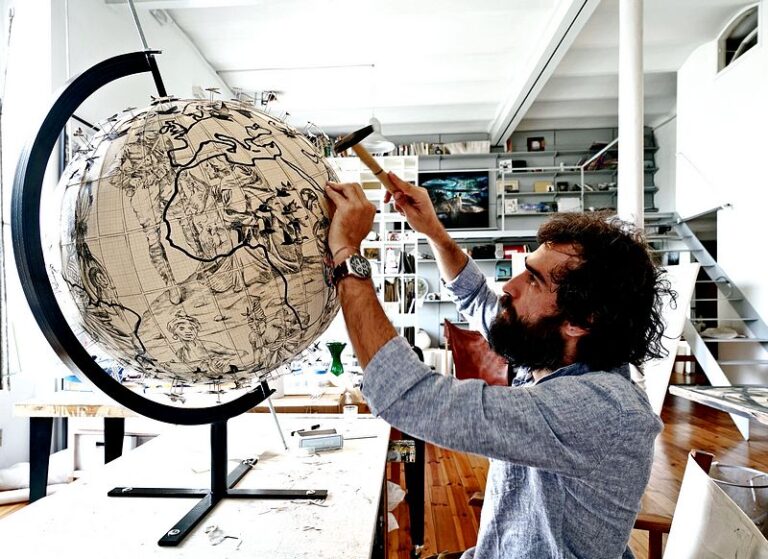ART, WHATEVER IT TAKES
Since the early pandemic in 2020, Rome Art Program has conducted a series of interviews, “Art, Whatever It Takes.”
Artists, Art Critics, and Art Historians living in Italy, the U.S., and U.K., share their insights during these powerful times.

Interview with Pietro Ruffo
Pietro Ruffo is a Roman artist: he studied architecture at the University of Rome, then became a research fellow at the Italian Academy at the Columbia University NY. He won the Premio Cairo (2019), and the Premio New York (2010).
For Pietro Ruffo, drawing and carving are instruments of research that analyze historical and contemporary dynamics, his works overlap natural landscapes & human figures, geographical maps & constellations, a stratified work with multiple visual and semantic layers.
Pietro Ruffo exhibited in many solo shows, at the Vatican City, São Paulo, China, Washington DC, MAXXI & Galleria Nazionale d’Arte Moderna – Rome, Tunisia, India. In 2021 he realized the work “Migrante” inside Villa Borghese-Rome. Some of Pietro Ruffo’s works are included in important public and private collections.
RomeArtProgram: What is your definition of “art” today?
Pietro Ruffo: Today as yesterday, art is the mirror of contemporaneity.
RAP: Art is dynamic and regenerates itself… how does it change, and how did it change us?
Pietro Ruffo: This mirror reflects the contemporary, but above all creates a projection into the future.
RAP: When (and how) did you understand that art was becoming very important in your life?
Pietro Ruffo: I grew up surrounded by art, with a grandfather who was a painter, a father who was an architect, and a mother who was a costume designer, as a child contemporary art was not alien, but an extraordinarily everyday matter.
RAP: What role does art play today? What are the “great figures” who have recently changed it? Do you feel close to any of these figures?
Pietro Ruffo: Art produced by other artists is still the thing that excites me a lot: it moves me, it excites me, I could name an artist who represents the symbol of each decade, it doesn’t have to mean necessarily the best but the one who revolutionises the language; for the last few years I certainly think of Banksy.
RAP: Are there still traditional figures such as collectors, muses, mecenate and patrons, in today’s art and society interaction model?
Pietro Ruffo: Yes, if I look back at art history, I find similar patterns to contemporary ones, just with different actors.
RAP: How have the new technologies and media culture changed art today, improving or worsening it…? What do you feel are your biggest challenges?
Pietro Ruffo: Any cultural, technological, scientific advancement is undoubtedly also positive when it is reflected in art; my challenge is to use classical tools with a language that can speak to my contemporaries.
RAP: Art as a mirror of man, in this moment of emergency seems to be shattered …what do these fragments reflect now?… Shadow or light of the moment?
Pietro Ruffo: Every historical period, analysed in its moment was a period of emergency, to think of living in exceptionality is a form of egocentrism that I try to avoid. The today’s “fragments” certainly reflect an intense and wonderful light.
RAP: Understanding, interpreting, and then possibly judging the work of art; which is the right path when we are in front of a piece of art?
Pietro Ruffo: First of all, get the phrase out of your mind: I could have done that too, also because we could do EVERYTHING, but we are lucky that there is someone more brilliant than us to do it for us.
RAP: Which is the real role of Academies and Art schools today? What can artists learn from these institutions today?
Pietro Ruffo: That art is a craft, and not the stunt of an evening, or a slogan to post, is the most beautiful craft, and the most hurtful craft in the world.
RAP: Art too has undergone a complex process of globalization; can having an authentic and genuine style be an advantage or a drag for an artist?
Pietro Ruffo: Certainly artists know how to speak using an ‘international’ language addressed to a wide audience, but the most interesting thing in the work of an international artist is to recognise what his/her cultural origins are, and what the perspective on society is.
RAP: How do Art Galleries and Museums position themselves today, and, in your opinion, how should they?
Pietro Ruffo: Drawing, painting, installing, that is my job, not running a museum institution, there are people who do it very well, and they certainly don’t need my advice on how to do that job.
RAP: “Figurative” or “Abstract” ? Which of the two is better descriptive of the period we live in? Which one will have a better future?
Pietro Ruffo: Figurative, Abstract, Conceptual, Hyperrealist, Concrete… the definitions are given later, the roads are many and all of them viable, and none of them are the right one, because they belong to categories linked to the past, while the right road has fortunately not yet been defined by critics.
RAP: Today we often speak of “emerging artists”; what advice based on your experience do you feel you can give to young artists?
Pietro Ruffo: To be as curious as possible, to contaminate one’s work with different disciplines, and to work every day.
RAP: Art as a lens for reading the present, can it modify the space and time we pass through? …will art save us?
Pietro Ruffo: In 2012 I had a solo exhibition in Barcelona entitled: “We have not yet saved”. We are always waiting for someone -or something- to come along in order to save us; too often we are too lazy to try to save ourselves, with art or without it.
@pietroruffoartist
